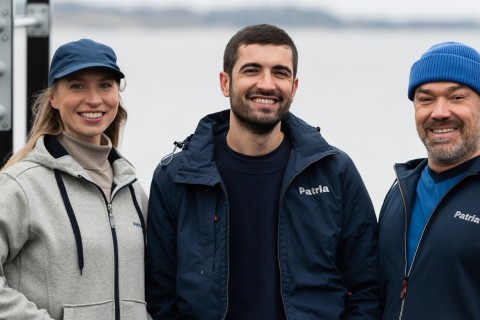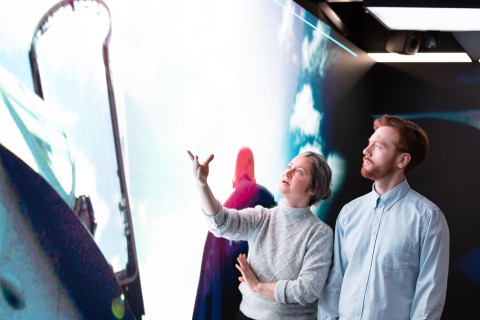
The GO Training System Is the High Point of Patria’s Achievement
12.6.2019
Patria has manufactured high level training systems and simulators for land, sea, and aviation uses for two decades. Through the years Patria has mastered various sectors in this field. Patria reached its high point in March as it delivered the G 115E training system to the Finnish Air Force.
Text: Samppa Haapio
Photos: Harri Hinkka
The new simulator system is located at an Air Force base in Tikkakoski, Finland. The system’s four simulator units are interconnected, enabling four trainees to fly together in a shared virtual airspace.
Patria’s Extensive Know-How in Simulators
The project was initiated in the autumn of 2017. The simulator training system was designed in cooperation with the Finnish Air Force. Patria was free to create its own designs as long as the client’s training needs were met. - Our client informed us of the types of training they need to provide. Our purpose was to find the optimal solutions to meet the client’s needs, says the simulator project’s main designer, Mika Junttila from Patria's Systems Business Unit.
- We are experienced designers and builders of training devices, and through the years our expertise has expanded to cover wide-ranging simulator solutions. Our central area of expertise is in challenging forms of system integration. We have the ability to produce solutions which connect real avionics devices with simulators. Our desire was to design an attractive device, which would appeal also to students, says Keijo Haapanen, project manager for simulators.
Eight Patria employees were active in this project. The simulator project was interdisciplinary because it utilised Patria’s various areas of expertise in aviation and in training systems. The key technical sectors included: avionics integration, visual systems design, flight mechanical model, program development, electronics design, and mechanical design. Test pilots from the Finnish Air Force and Patria provided important feedback for developing the optimal simulation. Top level skills in program design and systems integration play a key role in the implementation of an excellent networked training system.
Patria has worked on flight simulators networking for 20 years, and through this period the relevant technologies have advanced tremendously. These days the simulators are networked primarily by means of HLA (High Level Architecture), but also the older DIS protocol is still in use. The simulators use a so-called CGF (Computer Generated Forces) program. This CFG program places AI-controlled and realistically behaving synthetic aircrafts into a virtual airspace. These can be used for instance to practice flying in crowded airspaces. The instructor uses a specifically designed IOS (Instructor/Operator Station) program to manage the sessions and the virtual world, selecting suitable challenges for the trainees. - We process our clients’ requests in such a way that software developers can code without having a deep aviation knowledge as such. If we encountered problems, these were solved by means of experiments and tests, Junttila adds. - Mika and I have a background in aviation, and this has clearly been our strength throughout this project, says Haapanen.
A High-Fidelity Replica of a Cockpit
The designing process raised various questions, both small and large, and each of them contributed to the final product. How can new aeroplane avionics be integrated in a simulator? Should the cockpit have a windscreen? What system is to be used to generate the image which the trainee sees? How are failures to be modelled? How can the landscape be projected onto the bent screen without distortions? Simulator project went along with Finnish Air Forces training fleet modernisation. The cockpits of the simulators were made into exact copies of the real aeroplanes. A 3D scan was produced of the aeroplane’s cockpit, and this was the basis for a 3D model for the simulator. This model was then used to produce moulds for the fibre-reinforced simulator fuselage. In the simulator, the instructor is seated immediately behind the trainee in the cockpit. An industrial designer was responsible for shaping of the cockpit and for the design of the overall system’s ergonomics. The instructor is placed at an adjustable and purposely designed table with a computer screens and a chair. The instructor can select different parameters for each task, for instance the weather conditions, other aircrafts, failures or a specific location.
A Long List of Subcontractors
- Many of the simulator equipment are manufactured outside Finland, but the production and the assembly have been conducted here. We have made ample use of Patria’s local subcontractors. For example, we knew from earlier projects that there is plenty of cost efficient Finnish know-how on fibre-reinforced composites and mechanical engineering industry. Also the simulator’s landscape graphics are from a Finnish company, Haapanen says. - We are able to integrate different systems. The simulator’s systems and devices are largely identical to those of a real aircraft, and Patria was able to integrate these elements into the virtual world of the simulator, says Haapanen.
More Cost-Effective Training
The simulator system was adopted by the Finnish Air Force in March 2019. The Finnish Air Force uses this system to train conscripts and cadets. The new simulator system allows the Air Force to train their personnel more extensively than ever before. The system prepares trainees for modern combat aircraft avionics at an early stage. Networking and computer generated targets makes it possible to offer trainees elements from tactical flight training.
- The conversion from basic flight training to fast jet planes used to be dramatic. Only very few countries in the world provide trainees with this complete a training experience on an introductory level, Haapanen says. One of the main benefits of using simulators is in the much lower cost. The cost of operating a simulator is a fraction of the cost of operating a real aircraft. - But there are also no limitations due to weather conditions, and there is no risk of an incidence. The simulator enables one to do things one could never do with a real plane, and the instructor can select challenging situations with a mere click of the mouse. One cannot use a real aeroplane to practice flying into a flock of birds or in icy conditions, Haapanen notes. The demand for training programs of this purposely designed and networked type is continually on the rise. Simulators and LVC training technologies are now being invested in heavily, and Patria is a world leader in this field. New technologies make for new opportunities, and in the future simulators will be even more central to training procedures - no matter what the service branch.
What did you like about the article?
Thank you for your opinion! You can share the article on social media using the buttons below:

























